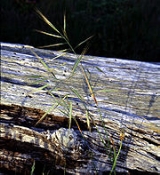
Bromus diandrus
Encyclopedia
Bromus diandrus is a species of grass
known by the common names great brome and "ripgut brome".
This is a brome grass
which is native to the Mediterranean
but has been introduced
to much of the rest of the world. It does best in areas with a Mediterranean climate
, such as California and parts of southern Australia, but it is quite tolerant of many climates.
The adult plant is one to three feet in height with hairy, rough leaves about a centimeter wide. The membranous ligule
is prominent, white in color with spiky hairs. The wide panicle
nods like that of an oat
plant, and it bears a large, splayed spikelet with a very long awn which can exceed five centimeters in length. The seeds easily break out of the spikelet. They are very sharp and very rough due to tiny barb-like hairs that face backwards, allowing the seed to catch and lodge like a fish hook
. This characteristic makes the seeds a danger to animals, which can easily get a seed lodged in a paw or eye. Motion can cause the seed to work itself deeply into flesh. This is one of several grass species known to pet owners as "foxtail
s", a backyard hazard for outdoor cats and dogs.
in California
native plant|native]] habitat
s.
Poaceae
The Poaceae is a large and nearly ubiquitous family of flowering plants. Members of this family are commonly called grasses, although the term "grass" is also applied to plants that are not in the Poaceae lineage, including the rushes and sedges...
known by the common names great brome and "ripgut brome".
This is a brome grass
Bromus
Bromus is a large genus of the grass family . Estimates in the scientific literature of the number of species have ranged from 100 to 400, but plant taxonomists currently recognize around 160–170 species...
which is native to the Mediterranean
Mediterranean Basin
In biogeography, the Mediterranean Basin refers to the lands around the Mediterranean Sea that have a Mediterranean climate, with mild, rainy winters and hot, dry summers, which supports characteristic Mediterranean forests, woodlands, and scrub vegetation...
but has been introduced
Introduced species
An introduced species — or neozoon, alien, exotic, non-indigenous, or non-native species, or simply an introduction, is a species living outside its indigenous or native distributional range, and has arrived in an ecosystem or plant community by human activity, either deliberate or accidental...
to much of the rest of the world. It does best in areas with a Mediterranean climate
Mediterranean climate
A Mediterranean climate is the climate typical of most of the lands in the Mediterranean Basin, and is a particular variety of subtropical climate...
, such as California and parts of southern Australia, but it is quite tolerant of many climates.
The adult plant is one to three feet in height with hairy, rough leaves about a centimeter wide. The membranous ligule
Ligule
A ligule — is a thin outgrowth at the junction of leaf and leafstalk of many grasses and sedges or a strap-shaped corolla, such as that of a ray floret in plants in the daisy family....
is prominent, white in color with spiky hairs. The wide panicle
Panicle
A panicle is a compound raceme, a loose, much-branched indeterminate inflorescence with pedicellate flowers attached along the secondary branches; in other words, a branched cluster of flowers in which the branches are racemes....
nods like that of an oat
Avena
The oats are a genus of 10-15 species of true grasses . They are native to Europe, Asia and northwest Africa. One species is widely cultivated elsewhere, and several have become naturalized in many parts of the world...
plant, and it bears a large, splayed spikelet with a very long awn which can exceed five centimeters in length. The seeds easily break out of the spikelet. They are very sharp and very rough due to tiny barb-like hairs that face backwards, allowing the seed to catch and lodge like a fish hook
Fish hook
A fish hook is a device for catching fish either by impaling them in the mouth or, more rarely, by snagging the body of the fish. Fish hooks have been employed for centuries by fishermen to catch fresh and saltwater fish. In 2005, the fish hook was chosen by Forbes as one of the top twenty tools...
. This characteristic makes the seeds a danger to animals, which can easily get a seed lodged in a paw or eye. Motion can cause the seed to work itself deeply into flesh. This is one of several grass species known to pet owners as "foxtail
Foxtail
-Plants:*Foxtail , the dry spikelet or spikelet cluster of some grasses** Alopecurus ** Bromus madritensis ** Hordeum jubatum...
s", a backyard hazard for outdoor cats and dogs.
Invasive species
Ripgut brome can substantially reduce yields when it invades wheat fields. It has naturalized in some areas and is considered a troublesome noxious weed in others. Bromus diandrus is an invasive speciesInvasive species
"Invasive species", or invasive exotics, is a nomenclature term and categorization phrase used for flora and fauna, and for specific restoration-preservation processes in native habitats, with several definitions....
in California
California
California is a state located on the West Coast of the United States. It is by far the most populous U.S. state, and the third-largest by land area...
native plant|native]] habitat
Habitat
* Habitat , a place where a species lives and grows*Human habitat, a place where humans live, work or play** Space habitat, a space station intended as a permanent settlement...
s.

